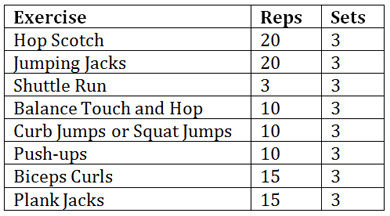Every kid needs strong bones, but what exactly does that mean? The strength of a bone can be measured by its bone mineral density, which is the amount of minerals (mainly calcium) contained in a certain volume of bone. When you have high bone mineral density, bones are solid and strong; low bone mineral density means bones are fragile and vulnerable to breaks. As we age, we begin to lose bone mineral density. Fortunately, our kids don’t have that problem—they are building solid healthy bones.
Calcium is an important factor, but not the only factor that determines bone mineral density. Weight-bearing activities are also a major contributor to healthy strong bones. A person in a wheelchair, on bed rest or living a sedentary lifestyle is at extreme risk of losing bone density. This is called osteopenia, which can lead to osteoporosis. Weight-bearing activities include anything that challenges us to fight the force of gravity, such as walking, running, skipping, jumping, hopping, hiking and weight lifting. Activities that are less weight-bearing (but still beneficial) are swimming and biking. The activities that give us no weight-bearing exercise are things like playing on the computer, video games, reading, watching TV or sleeping.
Kids that are sedentary or inactive are also at risk of losing bone mineral density and not developing adequate bone strength. This can lead to early deformation of the skeleton such as kyphosis (forward slouching of the upper back), or increased risk of broken bones. Without a solid bone structure, kids are less likely to develop a strong and balanced muscular structure and will be even more likely to stay inactive and sedentary throughout their lives.
It’s easy to see how critical it is to encourage weight-bearing exercises for kids as well as adults. Here is an example of a weight-bearing exercise program that will help kids build strong healthy bones along with greater strength, coordination and aerobic conditioning.
Complete 1 set of each exercise (1-8) before beginning the next set.

Exercise Descriptions
1. Hop Scotch: Start with feet shoulder-width apart. Alternate by jumping off both feet simultaneously and landing on only one1 foot and then back to landing on two feet.
2. Jumping Jacks: Start with feet together and arms at your sides. Jump off the ground to bring your feet shoulder-width apart and hands above your head. Jump again to bring yourself back to the starting position. Repeat.
3. Shuttle Run: Set up two cones about 15 yards apart. Sprint from cone 1 to cone 2 and back as quickly as possible, repeat this three times.
4. Balance Touch and Hop: Balance on your left foot. Bend your left knee and hip to lower down and touch the ground with your right hand. As you come up from the ground, stand up tall and hop off the left foot and land back on the left foot. Repeat this 10 times on your left foot and then switch to the right foot.
5. Curb Jumps or Squat Jumps: If you have access to a curb, this is a fun way to do this move. Stand with feet shoulder-width apart at the bottom of the curb. Go down into a squat and as you come up, jump off both feet simultaneously and land on top of the curb. Step or jump back down to the bottom of the curb and repeat. If you don’t have a curb, pretend to jump up and onto something and then jump back.
6. Push-ups: Begin with hands underneath your shoulders and feet together in plank position. Keep your body straight hovering over the ground and slowly lower toward the floor and then push back up
7. Biceps Curls: Use a set of free weights or sport cord with a moderateresistance. With weights or sport cord in your hands, start with your arms at your sides. Bend the elbows to bring the weights toward the shoulder. Slowly lower the arms back down to your sides.
8. Plank Jacks: From a push-up position, hold your body straight above the ground with your feet together. Simultaneously bring both feet wide and jump them back together. Repeat for 15 reps.




 by
by 






